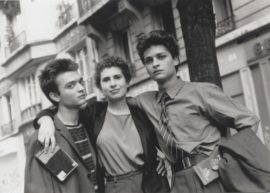Nuit et jour (Chantal Akerman, 1991) would seem like the ideal escapist fantasy about a summertime Paris, with a wide-eyed protagonist who spends her evenings strolling around the Seine, humming saccharine songs and shamelessly indulging in Nouvelle Vague coquetterie (she even cites Truffaut’s Baisers volés). At sunrise, she overlooks the romantic panorama of blue-colored Mansard rooftops from her deux-pièces apartment (while inside, lonely shadows are cast on brown peeling walls). During a nightly encounter, one of her lovers praises the City of Lights as diverse, multi-cultural and buzzing with activity in an affectionate Prévert-esque homage. “Because we we’re suffocating in Brussels!” the poor misunderstood 17-year-olds from Akerman’s short J’ai faim, j’ai froid (1984) try to explain their well-needed changer d’air.
Yet, as for those two girls, cosmopolitanism seems more of a pose than an actual conviction for the characters of Nuit et jour, three youths “probably from small villages in the Provence” (Akerman, the film’s narrator, indifferently mentions) who hermetically seal themselves in a ménage-a-trois bubble (spending their days in bed and their nights in motel rooms) and systematically shun outside influences. (Telephones are portrayed as needlessly intrusive, shutting the door for neighbor’s requests becomes a running gag and parents are treated like lepers when they show up for a surprise visit). The metropolitan vibrancy they so desperately seek is nowhere to be found in these deserted streets and Paris looks like a polished-up museum piece instead, a fleeting memory for hopeless romantics who remember the days when you could still rent a place near Place de la République on a cabdriver’s wage.

Far from portraying her characters as self-absorbed brats, Akerman seems more compassionate (and more pessimistic) about their fate, highlighting both their inability to communicate (our clever lovebirds hide in rhetorical games, third-party characters often remain hors-champ to illustrate confinement) and their awkward and mismatched relationship with both architecture and objects (the first dent in a couple’s love affair appears when their carefully choreographed ritual of running down the stairs goes out-of-synch). Even Akerman’s frequent use of shot-reverse-shot dialogue – a departure from her usual style of static long takes – seems to express alienation. Or was this stylistic choice inspired by an attempt to reach a mainstream audience, as the prefab eulogies in the Belgian press had us believe? Perhaps Akerman had simply gotten weary of being the 70s avant-garde poster child and this was her way of rebelling (during one of the Zomerfilmcollege 2016 lectures, Hilde D’haeyere made the comparison with the image of an annoyed girl sticking her tongue out), making an unapologetic ode to supposedly lesser genres such as musicals, slapstick and the romantic comedy.
Or maybe Akerman felt more at ease hiding autobiographical themes in comedy clichés than being painfully honest about them. The opening scene of Golden Eighties (1986) for instance – where we see a girl consecutively making out with two boys and pledging her love to both of them – might serve as the hook for a light-hearted romp, even though Akerman’s own expressed views on romance (in an interview about Golden Eighties with Jan Decorte for Flemish Television, she claims to agree with the shopkeeper’s philosophy on love: “if a skirt doesn’t fit, just go out and buy a new one!”) sounded cynical at times and reflected an indecisiveness more deep-rooted than your average ‘he loves me, he loves me not’ petal picking. Near the end of Nuit et jour, a similar mask is to be found in a scene referring to the many casual hooks-ups from Toute une nuit (1982), when the narrative functionality of two lovers being led to the gloomy dance floor by separate suitors (symbolizing their definitive breakup) hides a more profound urge: the need for an unknown embrace, that magical moment where heartbeats match the rhythm of mediocre pop songs.